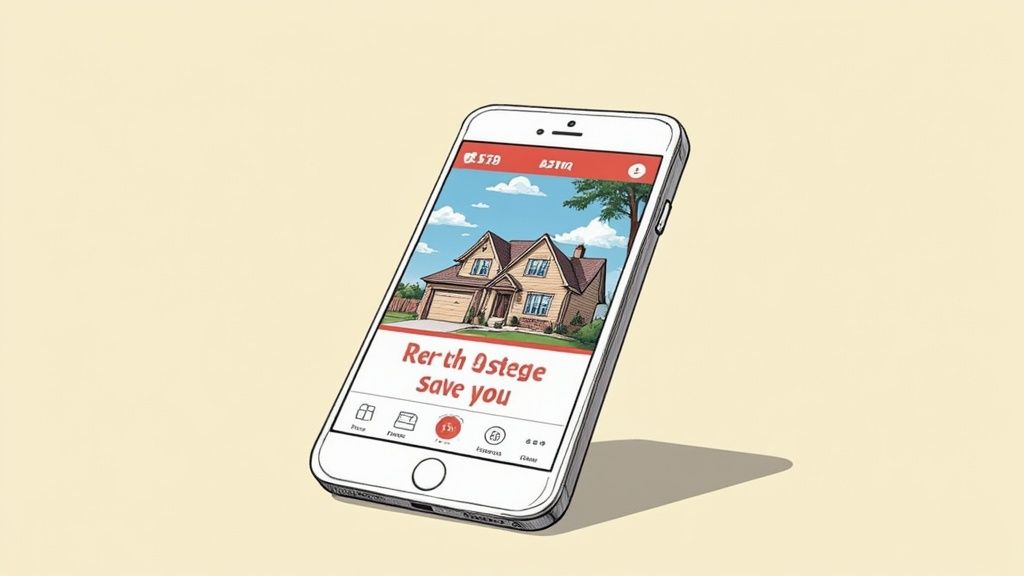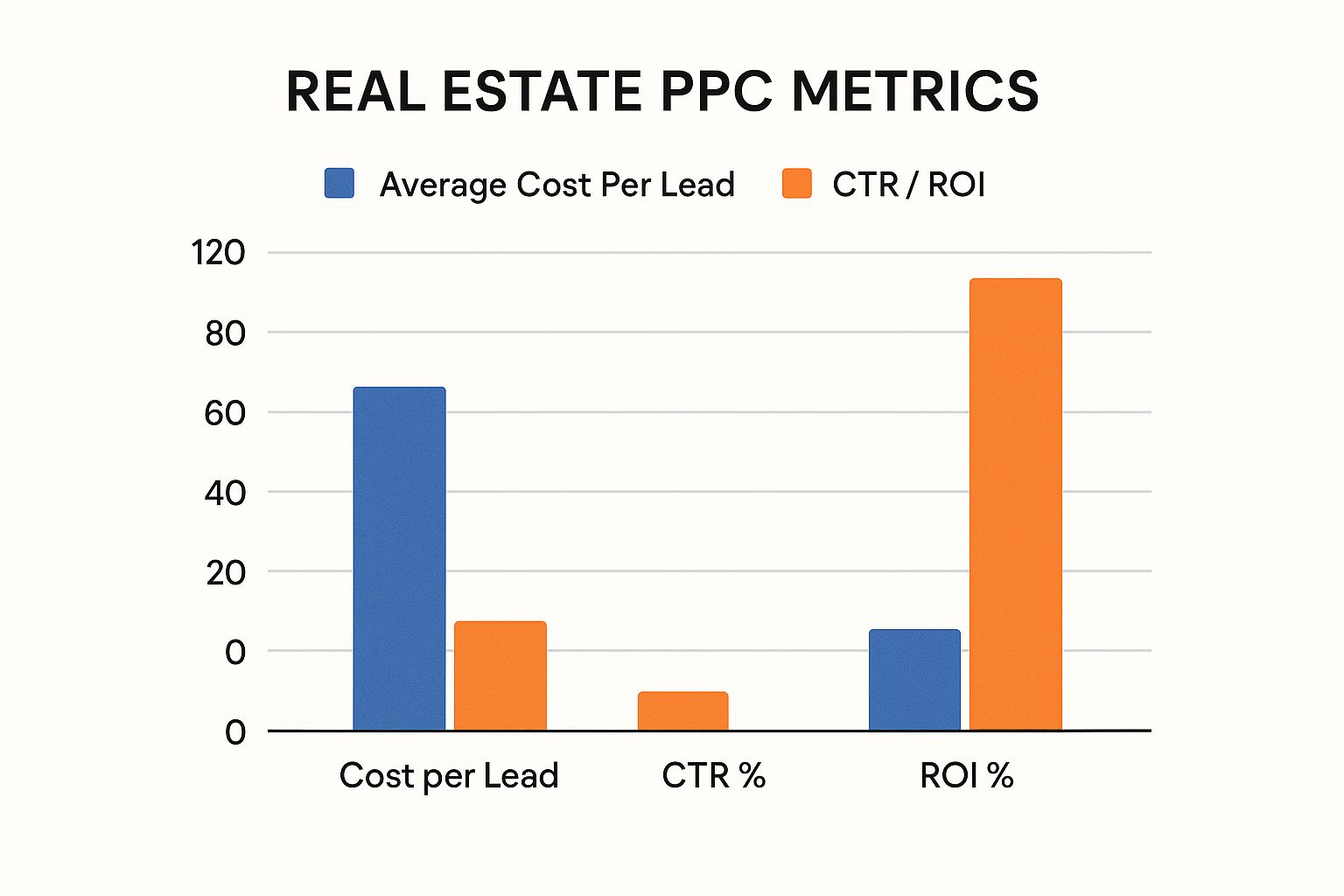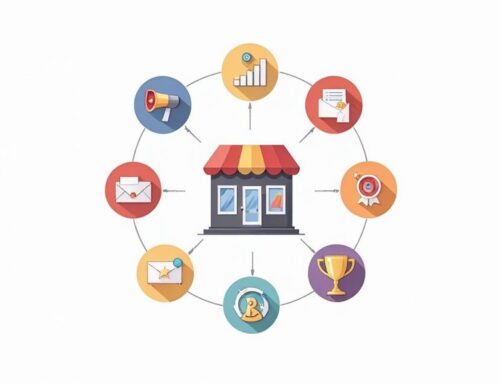In the world of real estate, getting in front of the right person at the right time is everything. That’s precisely what Real Estate PPC (Pay-Per-Click) Marketing is all about. It’s a straightforward digital advertising model where you pay a small fee only when someone actively clicks on your ad.
Think of it as the ultimate shortcut. Instead of waiting months for your website to climb Google’s rankings through SEO, PPC puts you at the top of the search results, instantly connecting you with motivated buyers and sellers.
Why PPC Is Your Fastest Path to Quality Real Estate Leads

Old-school marketing tactics like print mailers and billboards are like casting a huge, expensive net and hoping for the best. Real estate PPC, on the other hand, is like using a laser-guided fishing rod. It gives you incredible precision, allowing you to zero in on high-intent clients right when they’re searching.
Let’s get practical. Someone in your area just typed “luxury homes for sale in Scottsdale” or “first-time homebuyer programs in Denver” into Google. With a sharp PPC campaign, your ad is the first thing they see—positioning you as the go-to expert who can solve their exact problem.
Gain Immediate Visibility and Control
The biggest advantage of PPC is its speed. Unlike SEO, which is a long game, your PPC ads can be live and generating traffic within hours. In a market where listings can sell in a weekend, that kind of immediacy is a game-changer.
This is especially powerful for local PPC campaigns. You can target specific zip codes, a few key neighborhoods, or even a one-mile radius around a new open house. This ensures every dollar you spend is focused on the most relevant audience. You’re not just buying ad space; you’re buying direct access to motivated people in your farm area. You can learn more about how this cost-effective and targeted approach benefits real estate professionals from our partners.
Achieve Measurable Real Estate Marketing ROI
Perhaps the most compelling part of PPC is that everything is trackable. You can see every click, every impression, and every lead that comes through. This gives you a crystal-clear view of your real estate marketing ROI and tells you exactly what’s working and what isn’t, so you can make smart, data-driven decisions on the fly.
Key Takeaway: PPC turns your marketing from a guessing game into a predictable system. It stops being an expense and becomes a strategic investment that generates a reliable stream of qualified inquiries, fueling your business growth.
This is why PPC has become such a trusted tool in the industry. Data consistently shows that 93% of marketers view PPC as an effective channel. For real estate agents, this translates into a powerful, efficient engine for generating targeted leads and staking a claim in your local market.
Real Estate PPC vs Traditional Marketing at a Glance
Wondering how PPC stacks up against the methods you might be more familiar with? This quick comparison shows why PPC offers a significant advantage for realtors who want immediate, measurable results.
| Attribute | Real Estate PPC Marketing | Traditional Marketing (e.g., Print, Mailers) |
|---|---|---|
| Speed to Market | Instant visibility; ads go live in hours | Slow; can take weeks for design, print, and distribution |
| Targeting | Hyper-specific (zip code, demographics, keywords) | Broad and general; low precision |
| Cost Control | Pay only for clicks; set daily budgets to the dollar | Fixed upfront costs, regardless of engagement |
| Measurability | Highly trackable ROI; every click and lead is counted | Difficult to measure direct impact on leads or sales |
| Flexibility | Campaigns can be paused or adjusted in real-time | Inflexible; cannot change once printed or mailed |
| Audience Intent | Reaches users actively searching for real estate services | Interrupts people who may have no current interest |
As you can see, PPC provides a level of control and insight that traditional methods simply can’t match. It empowers you to invest your marketing budget with confidence, knowing you can track the return on every dollar spent.
Building a PPC Campaign That Actually Works
Let’s be honest: a lot of agents get burned by PPC. They throw money at Google, hope for the best, and end up with a costly bill and very few real leads to show for it. A profitable campaign isn’t about luck; it’s about laying the right groundwork before you even think about writing an ad.
Think of it like building a house. You wouldn’t just start nailing boards together without a blueprint. The same goes for PPC. The prep work you do—defining your target, understanding their search behavior, and knowing your numbers—is what separates a lead-generating machine from a money pit. This initial strategy is what will ultimately drive your PPC advertising for real estate toward a solid ROI.
Go Deeper Than Just Demographics
Every agent can describe their target market in terms of age and income. That’s entry-level stuff. To get truly targeted real estate leads, you have to think about intent. What are people actually doing online that screams, “I’m ready to move”?
Instead of just targeting “couples aged 30-45,” let’s get specific. What problems are they trying to solve?
- The Upgrader: This family isn’t just looking for a house; they’re searching for “best school districts in [Your City]” or “4-bedroom homes with a yard.” They’ve outgrown their current space, and their search terms prove it.
- The Down-Sizer: A recent retiree isn’t typing in “houses for sale.” They’re looking for “single-story homes for sale near me” or “55+ communities in [Your County].” They’re after a specific lifestyle change.
- The Relocator: Someone moving for a new job has a unique set of needs. They’re searching for things like “physician mortgage lenders in [Your State]” or doing a “cost of living comparison [Your City] vs. [Another City].”
When you frame your ideal client around their immediate needs and search intent, your ads can speak directly to them in a far more compelling way.
Master the Art of High-Intent Keyword Research
Once you know who you’re after, you need to figure out the exact words they’re typing into the search bar. This is the heart and soul of effective real estate lead generation ads. Sure, you can bid on broad terms like “homes for sale,” but you’ll be competing with the big portals and paying a fortune for every click.
The real gold is in the long-tail keywords. These are longer, more specific phrases that, while having less search traffic, convert at a much higher rate. Why? Because the person searching knows exactly what they want.
Think about the difference:
- “lakefront property for sale near Austin TX”
- “new construction homes under $500k in Raleigh”
- “condos with a city view in downtown Miami”
Fire up a tool like Google’s Keyword Planner and start with some basic “seed” keywords for your niche (e.g., “luxury homes,” “first-time buyer,” “military relocation”). The planner will spit back hundreds of long-tail ideas that real buyers and sellers are searching for right now. This isn’t guesswork; it’s using data to get inside your client’s head.
Calculate Your Budget—The Smart Way
So, how much should you spend? Don’t just pull a number out of thin air. Your budget should be directly tied to your business goals and your desired real estate marketing ROI. Before you set a daily ad spend, you absolutely must figure out your target Cost Per Lead (CPL).
Here’s a straightforward way to work backward and find your magic number:
- Know Your Average GCI: First, what’s your average Gross Commission Income per deal? Let’s use $9,000 as an example.
- Set Your Marketing Spend: How much of that commission are you willing to invest to get the next deal? A common benchmark is 10-15%. Using 10%, that gives you $900 to spend to acquire one closed client.
- Be Brutally Honest About Your Conversion Rate: What percentage of online leads do you actually convert to a closing? If you’re really good, it might be 3-5%. Let’s be conservative and say it’s 2%, meaning you need 50 leads to close one deal.
- Do the Math: Now, just divide your marketing spend per deal by the number of leads you need.
Let’s put it all together:
$900 (Your Max Spend Per Deal) ÷ 50 (Leads to Get a Deal) = $18 Target Cost Per Lead
This $18 is now your north star. As your campaign runs, you can measure your actual CPL against this target. If you’re spending $25 per lead, you know it’s time to optimize your ads or landing pages. If you’re getting leads for $15, you’ve built a profitable system you can confidently scale.
Creating Real Estate Ads That Actually Convert

Think of your ad as the digital handshake that introduces you to a potential client. A weak, generic ad gets scrolled past without a second thought. But a powerful, compelling ad? That’s what turns a casual searcher into a warm, targeted real estate lead.
The real goal here isn’t just to get clicks—it’s to get the right clicks from people who are genuinely serious about making a move. Crafting effective real estate lead generation ads is less about being a creative wordsmith and more about understanding psychology and being precise. It all boils down to identifying a searcher’s immediate need and positioning your service as the clear solution.
Writing Headlines That Grab Attention
Your headline is 80% of your ad. Seriously. If it doesn’t hook them, the rest of your carefully crafted copy is invisible. Generic lines like “Homes for Sale in [City]” are the digital equivalent of beige wallpaper—they blend in and get ignored.
To truly stand out, you have to speak directly to what the searcher wants or what’s bugging them.
Here are a few formulas I’ve seen work wonders:
- Hit a Pain Point: “Tired of Renting? View Starter Homes Under $400k”
- Showcase Something Unique: “New Listings with Pools in Phoenix – Updated Hourly”
- Offer an Irresistible Benefit: “Get a Free Home Valuation in Under 60 Seconds”
- Create a Little FOMO: “These Downtown Condos Are Selling Fast. Tour Today.”
Each of these examples connects with a specific buyer or seller, making the ad feel personal and relevant. This isn’t just theory; this approach is proven to boost click-through rates because it promises an immediate, valuable answer to their search.
Maximizing Clicks with Ad Extensions
Ad extensions are your best friend on the search results page. Think of them as free upgrades that let your ad take up more space, provide more info, and give people more reasons to click on your ad instead of your competitor’s. Frankly, running cost-effective realtor ads without them is non-negotiable.
For real estate, these are the heavy hitters:
- Sitelink Extensions: These are extra links that appear below your main ad. Use them to point people directly to high-value pages like “Neighborhood Guides,” “Featured Listings,” or a “Mortgage Calculator.”
- Call Extensions: This one’s a no-brainer. It puts your phone number right in the ad, so mobile users can call you with a single tap. It’s perfect for capturing those high-intent leads who are ready to talk now.
- Image Extensions: A picture really is worth a thousand words. Adding a high-quality photo of a stunning kitchen or a home’s beautiful exterior can make your ad visually pop off the page.
- Price Extensions: Get straight to the point. Showcasing specific listings with their prices gives searchers the transparency they crave and helps pre-qualify your clicks.
The data absolutely backs this up. PPC advertising for real estate sees incredibly high engagement, and ad extensions are a huge part of that success. The real estate sector enjoys an impressive average click-through rate (CTR) of 9.09%, which is miles ahead of the median for all industries. It just shows that when ads are well-built and informative, people are eager to engage.
The Non-Negotiable Landing Page
This is it. This is the spot where so many real estate PPC campaigns fall flat on their face. You can write the world’s most perfect ad, but if you send that hard-earned traffic to your generic homepage, you’re just lighting money on fire.
Your homepage is built for everyone. A landing page is built for one specific action.
A dedicated landing page is the single most important factor for converting clicks into leads. Its only job is to fulfill the promise made in your ad.
If your ad promises “a list of homes with pools,” your landing page better deliver exactly that—and nothing else. Strip away all the distractions. That means no main navigation menu, no links to your blog, no agent bios. The page needs a clear headline that mirrors the ad, a dead-simple lead capture form, and a big, obvious call-to-action button. By keeping the user focused, you’ll see a massive improvement in converting those clicks into actual leads. You can learn more about data-driven decision-making in our guide on the topic.
Launching and Managing Hyper-Local PPC Campaigns

Alright, you’ve done the prep work. Your strategy is mapped out, and your ad copy is ready to go. Now comes the exciting part: bringing your campaign to life. This is where the rubber meets the road, and you start turning that planning into real-world results.
But let’s be clear. The most successful local PPC campaigns for realtors are never “set and forget.” Think of them as living, breathing marketing engines that need your attention to perform at their best. It’s not about just flipping a switch; it’s about making smart, deliberate choices that connect with your specific local market and turn your ad spend into a predictable stream of targeted real estate leads.
Pinpointing Your Audience with Geo-Targeting
This is the secret sauce of real estate PPC. The incredible precision of geo-targeting is what makes it so powerful. You’re not just shouting into the void of an entire city; you’re speaking directly to potential clients in the exact neighborhoods and communities you know like the back of your hand.
Google Ads gives you some fantastic tools to zero in on your ideal locations:
- City or Zip Code Targeting: This is your foundation. Start by selecting the specific cities or zip codes where you want to be the go-to agent.
- Radius Targeting: This is a game-changer, especially for promoting a new listing or an open house. You can draw a circle as tight as a one-mile radius around an address, showing your ad only to people searching right there.
- Neighborhood Targeting: While there isn’t a “neighborhood” button, you can get very close. By strategically layering zip codes and radius targeting, you can effectively fence off the specific communities you want to dominate.
This level of control means you stop wasting money on clicks from people looking in areas you don’t even serve. Every dollar is focused where it matters most, directly boosting your real estate marketing ROI.
Choosing the Right Bidding Strategy
Once you’ve decided where your ads show up, you need to tell Google how to pay for them. Your bidding strategy is essentially your set of instructions for how the platform should spend your budget to hit your goals. You’ve got two main paths to choose from.
Manual CPC (Cost-Per-Click)
This approach puts you in the driver’s seat. You set the absolute maximum price you’re willing to pay for a single click on any given keyword. It’s a great option if you’re on a very tight budget and need to control every penny. The trade-off? It’s a lot of work. You have to constantly be in your account, monitoring performance and tweaking bids yourself.
Automated Bidding Strategies
Alternatively, you can let Google’s powerful machine learning algorithms do the heavy lifting. For real estate, a fantastic option is the Maximize Conversions strategy. You simply tell Google, “My goal is to get as many leads—form fills, phone calls—as I can for my budget.” Google’s AI then goes to work, adjusting your bids in real-time to hunt down the clicks that are most likely to turn into actual clients.
For most realtors starting out, I highly recommend handing the reins to Google’s “Maximize Conversions.” It crunches a mind-boggling amount of data to make split-second bidding decisions that you could never replicate on your own. It often leads to better results with far less hands-on effort.
Tracking What Truly Matters
This is the final, non-negotiable step before you hit “launch.” If you don’t track conversions, you’re essentially flying blind. You’ll see clicks, sure, but you’ll have no clue which keywords, ads, or targeting settings are actually making your phone ring.
Proper conversion tracking is the only way to genuinely measure your real estate marketing ROI. It works by placing a small piece of code on your website to tell Google when a user takes a valuable action after clicking your ad.
For a realtor, there are two critical events you must track:
- Lead Form Submissions: When someone fills out your “Contact Me” or “See More Homes” form, that’s a qualified lead. A tracking pixel on the “Thank You” page they see after submitting the form tells Google, “We got one!”
- Phone Calls from Ads: Many of your best leads won’t bother with a form; they’ll just call. Google Ads lets you use a dynamic call-forwarding number in your ads. When someone calls it, Google can track it as a conversion (typically for calls over 60 seconds) and attribute it back to the exact ad they saw.
By tracking both form submissions and phone calls, you get the full story. You can finally see which keywords are driving not just traffic, but tangible business, allowing you to confidently double down on what works and cut what doesn’t.
Optimizing Your Way to Lower Costs and Higher ROI
Getting your real estate PPC campaign live is a great first step, but don’t pop the champagne just yet. The real work—and the real profit—starts now. Consistent, thoughtful optimization is what separates the campaigns that fizzle out from the ones that become lead-generating machines. This isn’t about guesswork; it’s about learning to read the story your data is telling you and making smart, strategic moves.
A truly successful PPC advertising for real estate strategy is never “set it and forget it.” It’s a living, breathing thing that needs regular attention. By keeping a close eye on your key performance metrics, you can transform a decent campaign into a powerhouse for generating high-quality, targeted real estate leads.
Decoding Your Campaign’s Performance
Your campaign dashboard is a sea of numbers. To avoid drowning in data, focus on the handful of metrics that truly tell you what’s working and what’s not. These are the vital signs of your real estate marketing ROI.
- Click-Through Rate (CTR): This is simple: of all the people who saw your ad, what percentage clicked it? A low CTR is a red flag. It often means your ad copy isn’t grabbing attention or your keywords are misaligned with your ad’s message.
- Cost Per Acquisition (CPA): This is your bottom-line number—your true cost per lead. It tells you exactly what you’re spending to get one person to fill out a form or pick up the phone. Your mission is to keep this number comfortably below the target CPL you set during the planning phase.
- Conversion Rate: This metric reveals what percentage of people who clicked your ad actually became a lead. If this number is low, the problem usually lies with your landing page. Maybe it’s slow to load, confusing to navigate, or simply doesn’t deliver on the promise your ad made.
Get in the habit of checking these metrics weekly. This allows you to spot trouble early and make corrections before you burn through too much of your budget. For a deeper look into the numbers that matter, you can explore our complete guide on how to track and measure your campaign’s ROI effectively.
The Power of a Strong Negative Keyword List
Want the fastest way to improve your campaign’s efficiency? Start telling Google what searches you don’t want to show up for. This is done by building out a solid negative keyword list. Every single click from an irrelevant search is wasted money, and negative keywords are your best defense against this budget drain.
Put yourself in the shoes of someone you don’t want as a lead. If you specialize in residential sales, you absolutely don’t want clicks from people searching for commercial properties or apartments for rent.
Your starting negative keyword list should probably include terms like:
- rent
- apartments
- realtor jobs
- training
- cheap
- foreclosure
Make it a weekly ritual to dive into your “Search Terms” report in Google Ads. This is a goldmine. It shows you the exact, verbatim queries people typed before they clicked your ad. See something irrelevant? Add it to your negative list on the spot. This simple, ongoing habit is one of the most powerful things you can do to protect your budget and maintain lead quality.
Winning with Simple A/B Testing
You don’t need a PhD in data science to run effective tests. A/B testing (or split testing) is just a fancy term for a simple idea: run two slightly different versions of an ad or landing page to see which one performs better. Over time, these small, incremental wins compound into massive improvements in your conversion rates.
The easiest place to start is your ad copy. Just duplicate your current best-performing ad and change one single thing. You could test:
- A Different Headline: Try framing it as a question versus a statement. For example, pit “Ready to Sell Your Home?” against “Get Your Accurate Home Value.”
- A New Call-to-Action: Test “View Listings Now” against “See Homes Instantly.”
- Highlighting a Different Benefit: One ad could focus on “Luxury Finishes,” while its challenger talks about “Top-Rated School Districts.”
Let both ads run until they’ve gathered enough data (I usually aim for at least 100 clicks each). Then, simply pause the loser and create a new test to try and beat your new champion. Applying this same logic to your landing page headlines and call-to-action buttons can unlock even bigger gains.
Key Insight: Continuous optimization isn’t about making massive, sweeping changes. It’s about a relentless commitment to small, consistent improvements. Improving by just 1% every week adds up to a dramatically more profitable campaign over the course of a year.
Regularly optimizing your real estate PPC campaigns is crucial for maximizing your return on investment. The table below outlines some key actions you can take and the direct impact they’ll have on your campaign’s profitability.
Key PPC Optimization Actions and Their Impact
| Optimization Action | What It Involves | Expected Impact on ROI |
|---|---|---|
| Negative Keyword Mining | Regularly reviewing the “Search Terms” report and adding irrelevant queries to your negative keyword list. | Reduces wasted ad spend on unqualified clicks, directly lowering your cost per lead. |
| A/B Testing Ad Copy | Creating variations of your ads to test different headlines, descriptions, and calls-to-action against each other. | Increases Click-Through Rate (CTR) and Conversion Rate, leading to more leads for the same budget. |
| Landing Page Optimization | Improving page load speed, clarifying your headline, and ensuring your form is simple and mobile-friendly. | Boosts Conversion Rate, turning more of your expensive clicks into actual, valuable leads. |
| Bid Strategy Adjustments | Analyzing performance data to manually or automatically adjust bids for top-performing keywords, locations, or devices. | Focuses budget on the most profitable segments of your campaign, maximizing lead volume and quality. |
By consistently performing these tasks, you actively steer your campaign toward greater efficiency and a higher ROI, ensuring your marketing dollars are working as hard as possible.
The infographic below shows some key benchmarks that well-optimized real estate PPC campaigns often hit.

This data really drives the point home: while lead costs can vary, a strong click-through rate is well within reach and is a direct line to a healthier ROI. The whole point of real estate PPC marketing is to find that sweet spot where your lead cost is low and your return is high. Hitting these kinds of industry benchmarks is a clear sign that your hard work is paying off.
Your Top Real Estate PPC Questions Answered
Jumping into the world of PPC advertising for real estate always brings up a lot of questions. It’s a significant investment of both time and money, and you deserve to feel confident before you start. Let’s walk through some of the most common questions I hear from agents just like you.
How Much Should a Realtor Budget for PPC Ads?
There’s no one-size-fits-all answer here, but I’ve found that a great starting point for a solo agent is usually between $500 and $1,500 per month. This gives you enough runway to gather meaningful data and start seeing a consistent trickle of inquiries.
A better way to think about it, though, is to work backward from your goals. Let’s say you want to generate 20 new leads this month. If you figure out your target cost per lead is around $50, then you know your budget needs to be $1,000 for the month. This approach ties your ad spend directly to a business outcome, which is always the smarter way to invest.
Think of that initial budget as the fuel to get the engine started. Once you see it working and prove you can get a positive real estate marketing ROI, you can confidently step on the gas and scale up.
How Long Until I See Results from Real Estate PPC?
The speed of PPC is one of its biggest perks. Unlike SEO or content marketing, which can take months to build momentum, you can get clicks and impressions almost the moment your campaign goes live.
You should realistically expect your first targeted real estate leads to start coming in within the first week or two.
But getting a steady, profitable stream of leads takes a bit more patience. I always tell clients to plan for a 30 to 60-day “learning phase.” This is when the campaign is like a sponge, soaking up performance data that we’ll use for optimization. Most agents find their groove and hit a profitable rhythm after about 90 days of consistent management and tweaking.
Should I Run PPC Campaigns Myself or Hire an Agency?
Honestly, you can absolutely run your own local PPC campaigns for realtors. If you’re someone who enjoys getting your hands dirty with new tech and you have the time to dedicate, it’s a great way to understand your marketing inside and out. You’ll have total control.
However, if you’re already juggling a dozen other things or the thought of navigating Google Ads feels overwhelming, bringing in a specialized real estate PPC agency is a very smart move.
Their focused expertise can often generate a higher ROI much faster, easily covering their management fee. A good path is to try it yourself first to learn the fundamentals, then consider outsourcing as your business grows and your time becomes more valuable.
What Is a Good Conversion Rate for Real Estate Ads?
For cost-effective realtor ads, a healthy landing page conversion rate to shoot for is between 2.5% and 5%. I’ve seen some finely-tuned local campaigns do even better, but that range is a solid benchmark to aim for.
But here’s a pro tip: don’t get hung up on just the rate. The actual quality of the lead is what ultimately impacts your bank account.
A campaign with a 2% conversion rate that delivers motivated, ready-to-talk clients is infinitely more valuable than a campaign with a 10% rate that just sends a flood of tire-kickers and unqualified lookers. Always measure your conversion rate against your cost per lead and, most importantly, the quality of the conversations you’re having.
Navigating the world of PPC can be complex, but you don’t have to do it alone. The team at ReachLabs.ai specializes in creating data-driven marketing strategies that deliver real results for real estate professionals. Let us help you build a campaign that moves the needle. Learn more about our approach at https://www.reachlabs.ai.





